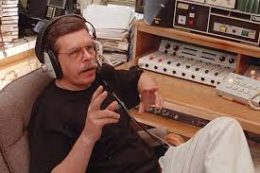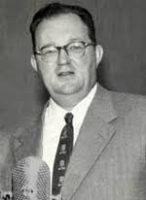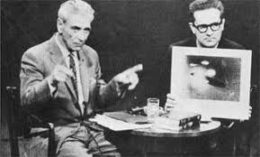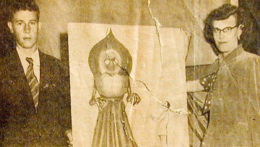By Charles Lear
 For many people, the late night radio show, “Coast to Coast AM” hosted by Art Bell, was their source for a steady stream of discussion on the subject of UFOs. It began in 1988 as a forum for political discussion with call-ins and interviews and, by 1995, it had evolved into a platform for the paranormal. Bell broadcast from his home in Pahrump, Nevada and handled five phone lines by himself putting unscreened call-in guests on the air to discuss strange experiences, conspiracy theories, UFOs and aliens. At its peak in the late 1990’s, the show was broadcast on over 500 stations and had an estimated 15 million listeners. Bell had discovered, and proven to others, that UFOs and the paranormal could be big business in broadcasting but, as would be expected given the long history of radio, he wasn’t the first.
For many people, the late night radio show, “Coast to Coast AM” hosted by Art Bell, was their source for a steady stream of discussion on the subject of UFOs. It began in 1988 as a forum for political discussion with call-ins and interviews and, by 1995, it had evolved into a platform for the paranormal. Bell broadcast from his home in Pahrump, Nevada and handled five phone lines by himself putting unscreened call-in guests on the air to discuss strange experiences, conspiracy theories, UFOs and aliens. At its peak in the late 1990’s, the show was broadcast on over 500 stations and had an estimated 15 million listeners. Bell had discovered, and proven to others, that UFOs and the paranormal could be big business in broadcasting but, as would be expected given the long history of radio, he wasn’t the first.
 Near the end of the year 1949, Frank Edwards, newscaster for the American Federation of Labor sponsored Mutual Broadcasting System, received an advance copy of the January, 1950 edition of True Magazine. Edward’s attention was captured by a, now historic, article by Donald E. Keyhoe, “The Flying Saucers Are Real.” Edwards got permission from the editor to break the story on air and from that moment on, continued to include UFO reports and other stories of Forteana in his broadcasts. Though not proven, it is quite likely that these new reports and stories were a great help in propelling Edward’s show to become one of the top three radio news shows in early ‘50s America. He left MBS in 1954 and, shortly thereafter, created and hosted a syndicated radio show called, “Stranger Than Fiction” which was fully devoted to Forteana and UFOs. Edwards is best known to UFOlogists as the author of the 1966 classic, “Flying Saucers – Serious Business.” Edward’s new radio show was short-lived but another broadcaster came up with a show of his own that would go on for many years with great success.
Near the end of the year 1949, Frank Edwards, newscaster for the American Federation of Labor sponsored Mutual Broadcasting System, received an advance copy of the January, 1950 edition of True Magazine. Edward’s attention was captured by a, now historic, article by Donald E. Keyhoe, “The Flying Saucers Are Real.” Edwards got permission from the editor to break the story on air and from that moment on, continued to include UFO reports and other stories of Forteana in his broadcasts. Though not proven, it is quite likely that these new reports and stories were a great help in propelling Edward’s show to become one of the top three radio news shows in early ‘50s America. He left MBS in 1954 and, shortly thereafter, created and hosted a syndicated radio show called, “Stranger Than Fiction” which was fully devoted to Forteana and UFOs. Edwards is best known to UFOlogists as the author of the 1966 classic, “Flying Saucers – Serious Business.” Edward’s new radio show was short-lived but another broadcaster came up with a show of his own that would go on for many years with great success.
 In August of 1956, the management of radio station WOR, with studios in New York City and a transmitter in Rutherford New Jersey, was unhappy with Jean Shepard, the host of their midnight to 5:00 a.m. show. Shepard was a storyteller much like Garrison Keeler of the more recent, “A Prairie Home Companion”, and the management asked him to play more music and talk less. This prompted Shepard to do the opposite and he was fired. Replacing him was John Nebel, who had just recently started broadcasting with the station. Nebel played music for a few weeks until he came up with an idea for a talk show where many evenings would be devoted to all things strange and unusual and the “Long John Nebel Show” came to be. At the time, there were no other shows like it on radio or television and the show became a hit. Nebel interviewed guests, took listener calls and had a group of “panelists” who were regulars on the show and acted as unpaid co-hosts.
In August of 1956, the management of radio station WOR, with studios in New York City and a transmitter in Rutherford New Jersey, was unhappy with Jean Shepard, the host of their midnight to 5:00 a.m. show. Shepard was a storyteller much like Garrison Keeler of the more recent, “A Prairie Home Companion”, and the management asked him to play more music and talk less. This prompted Shepard to do the opposite and he was fired. Replacing him was John Nebel, who had just recently started broadcasting with the station. Nebel played music for a few weeks until he came up with an idea for a talk show where many evenings would be devoted to all things strange and unusual and the “Long John Nebel Show” came to be. At the time, there were no other shows like it on radio or television and the show became a hit. Nebel interviewed guests, took listener calls and had a group of “panelists” who were regulars on the show and acted as unpaid co-hosts.
Prior to his radio show, Nebel had no particular personal interest in UFOs or the paranormal and his idea was, most likely, a calculated one after perceiving there was a strong public interest. Nebel was a young man during the Depression and had made his way from being an illegal street peddler to an auctioneer prior to his first radio broadcast. He was successful as a salesman and not above huckster style tactics. One example in the 1974 book by Donald Bain, “Long John Nebel: Radio Talk King, Master Salesman, Magnificent Charlatan” describes Nebel selling juice extractors on the street. He’d prepared oranges by injecting them with water and demonstrated the extractors with the catch-phrase, “Squeeze a little, get a little. Squeeze a lot, get a lot.”
Nebels’ show coincided with the rise of the contactee movement and they passed through the studio in a parade. Guests included: George Adamski, who claimed to have met a Venusian and visit other planets with him in his spaceship, George Van Tassel, who alleged he was inspired by space visitors to form his own church and who held an annual International Space Convention on a property near a huge freestanding boulder known as Giant Rock in California, and Orfeo Angelucci who told the story that he was given a magic potion to drink by a man named, Adam, which caused a five-inch blonde female to appear and dance “sensuously” until she fell to her knees exhausted. Angelucci also claimed a beautiful lady took him for a ride in her spaceship at speeds of up to ten million miles an hour. On one show described in Bain’s book, British contactee, George King, was confronted by the star of “The Honeymooners” and well known UFO enthusiast, Jackie Gleason. Gleason called him a liar and a phony and suggested that his Martian friends could provide legal aid if he wanted to sue him for libel.
 For those who completely discounted the contactees as charlatans or kooks, there were guests that could be taken more seriously. Arthur C. Clark was a guest well before he wrote “2001” and expressed skepticism that we were being visited as of 1958. Isabel Davis of Civilian Saucer Intelligence can be heard debating Jim Moseley, former CSI President and publisher of Saucer News arguing that there was a need for a scientific publication covering UFO sightings. Ivan T. Sanderson, long time UFOlogist, cryptozoologist (he coined the term) and primary investigator of the Flatwoods Monster case was a frequent guest and provided intelligent and urbane commentary on various aspects of the UFO mystery. One show had a fantastic discussion between Jackie Gleason, Frank Edwards, and Gray Barker, author of the 1956 classic, “They Knew Too Much About Flying Saucers.” The discussion started between Gleason and Edwards around a letter Barker had written to Nebel. Barker wrote that he’d been invited to be picked up by a flying saucer and taken to an island in the South Pacific that would be safe in the event of an “atomic” war. Barker joined the discussion and Gleason strongly criticized Barker for the letter to Nebel and for publishing, “From Outer Space To You”, a memoir by contactee Howard Menger, causing Barker to turn to Nebel for support. The discussion was only mildly heated compared to today’s on air disagreements and the three departed on friendly terms.
For those who completely discounted the contactees as charlatans or kooks, there were guests that could be taken more seriously. Arthur C. Clark was a guest well before he wrote “2001” and expressed skepticism that we were being visited as of 1958. Isabel Davis of Civilian Saucer Intelligence can be heard debating Jim Moseley, former CSI President and publisher of Saucer News arguing that there was a need for a scientific publication covering UFO sightings. Ivan T. Sanderson, long time UFOlogist, cryptozoologist (he coined the term) and primary investigator of the Flatwoods Monster case was a frequent guest and provided intelligent and urbane commentary on various aspects of the UFO mystery. One show had a fantastic discussion between Jackie Gleason, Frank Edwards, and Gray Barker, author of the 1956 classic, “They Knew Too Much About Flying Saucers.” The discussion started between Gleason and Edwards around a letter Barker had written to Nebel. Barker wrote that he’d been invited to be picked up by a flying saucer and taken to an island in the South Pacific that would be safe in the event of an “atomic” war. Barker joined the discussion and Gleason strongly criticized Barker for the letter to Nebel and for publishing, “From Outer Space To You”, a memoir by contactee Howard Menger, causing Barker to turn to Nebel for support. The discussion was only mildly heated compared to today’s on air disagreements and the three departed on friendly terms.
The Long John Nebel Show lasted until Nebel’s death at age 66 in 1978. Besides the groundbreaking aspect of the show, the history preserved by the recordings is invaluable. This was a magical time in UFOlogy before the paranoia and anger reflected in Bell’s show became prevalent. To be able to hear the actual voices of pioneers who have attained a legendary status in the field makes them more real and provides insight into their personalities that reading their writings can’t.
As this blog concerns recordings of UFOlogical discussions, the reader may be interested to know that this website was recently wiped clean by a hacker and Martin is still working to restore it. It’s an important task because this is our history too.